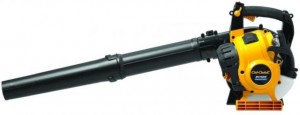If you’re looking at getting a new leaf blower for your home, you’re faced with one major choice: gas or electric? While electric blowers used to fall far behind the power of internal combustion models, today they’re almost evenly matched. Which type of Cub Cadet handheld will work best for you?
CORE CCU410 Power-Lok Drive Unit and CCB410 Power-Lok Blower Attachment
CORE stands for “Conductor-Optimized Rotary Energy.” In a nutshell, this motor design uses a printed circuit board in place of windings, creating a high power, lightweight, and compact motor. When Cub Cadet first released the CORE system to the market, they pitched it as a direct replacement for their 25cc two-stroke engine, offering similar power and performance. The lithium-ion battery can power the motor for up to 45 minutes and only takes an hour to fully recharge.
While there are two string trimmers that use the CORE drive system, the only blower available is an attachment that works with the CCU410 drive unit. Together, they move 400 CFM of air at 110 mph.
Together, the drive unit and attachment weigh 21.4 lbs. with a battery. Cub Cadet guarantees the CCU410 for 5 years.
BV 428
This gas-powered blower uses a 25 cc four-stroke engine, eliminating the high emissions, hard starting and oil mixing of two strokes. The motor is also EPA rated to meet emissions for 125 hours of use, while most two strokes at this end of the market are only built to last 50 hours. Even if you don’t care about what’s coming out of the exhaust, this makes a strong case for the motor’s superior durability.
With the CORE built to match Cub Cadet’s old two strokes, it would seem that it should easily out-power this four-stroke model. However, the BV 428’s wide torque band and efficient design give it the edge with an output of 450 cubic feet per minute at a speed of 150 mph. The entire blower minus fuel weighs just 13 lbs, making it easier to handle than CORE. Want to pick up leaves? This model can also be used as a vacuum. The BV 428 is covered by a three-year warranty.
Which One is Right for Me?
The BV 428 costs less than the CCU 410 Power-Lok Drive Unit and CCB 410 Power-Lok Blower Attachment combined, but if you’re looking to add or replace several tools in your lawn care arsenal, it may make more sense to start your CORE collection here and add the string trimmer and hedge trimmer attachments later on.
If you live in an area with heavy fall rains, the BV is a better fit as the extra wind speed is more effective at lifting wet, matted down leaves. For dryer climates, both blowers are about equal.
The long runtime per charge means its unlikely that you’ll rarely run out of power when using the CCB 410 when working on a residential lawn. The vibrations from the BV 428’s engine increase fatigue, but this is easily outweighed by its low weight, making it easy to carry and tilt to blow leaves away from buildings and fences.
Maintenance is also a strong point with the CCU 410, requiring only charging and a fresh battery every couple of years, and starting it is just a matter of pushing a button. However, the BV’s four-stroke engine makes it much easier to start and maintain than older two-stroke blowers. There’s no oil that needs to be mixed with the fuel, and there’s little that needs to be done outside of occasional oil changes, air filter cleanings and spark plug replacements.
In the end, going electric is the right choice if you put ease of use above everything, want a multipurpose tool that can be used most of the year, and don’t mind breaking out a rake after a major storm. If you don’t mind doing a little maintenance and have space for more equipment, Cub Cadet’s gas-powered handheld provides a little more comfort and power.
Getting Parts for Your Cub Cadet Leaf Blower
Whether you decide on gas or electric, you can get everything you need for your Cub Cadet from www.cubparts.com. As a certified dealer, we’re able to ship OEM parts across the U.S. and Canada ranging from carburetors to battery chargers.

